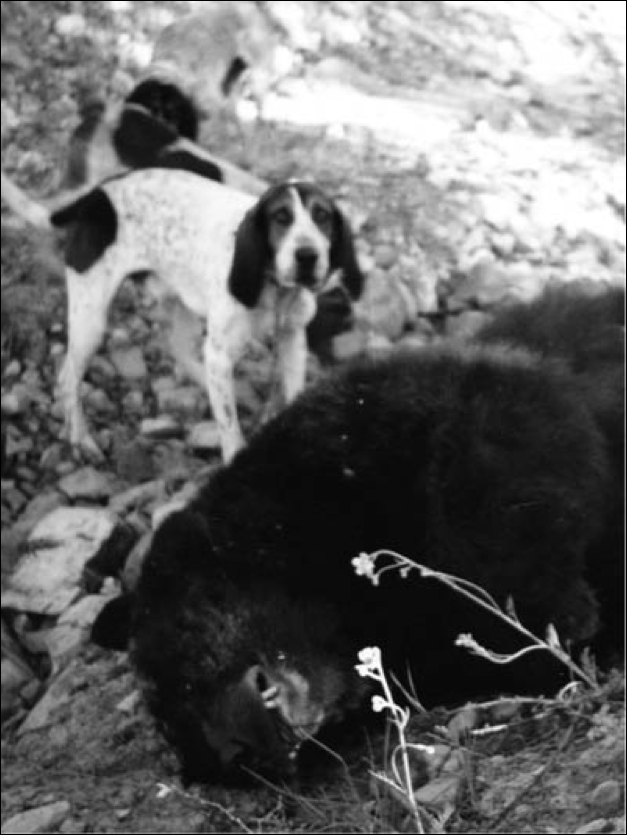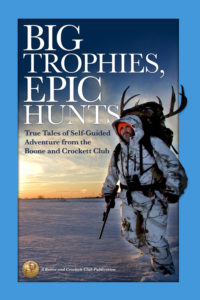Central Arizona may seem an unlikely place to hunt black bear, but bear do inhabit the brush and cactus covered mountains and canyons, and an inordinate number of them reach the huge proportions that hunters dream about. Maybe it’s the mild winters and abundant feed, or being able to reach a ripe old age in an isolated area, but for whatever reason, there are some enormous bears in Arizona.
Ingrained in the Southwest is a long and deep tradition of hunting bear with hounds. Many of the greatest of the lion and bear hunters, men like Ben Lilly and Monteque Stevens, Uncle Jimmy Owens and Homer Pickens, the Goswicks, the Evans, the Lee brothers, and many others, did their hunting in the rugged southwestern mountains. Theodore Roosevelt made numerous trips to Arizona and Colorado to hunt bear and lion behind a pack of local hounds. And even today, there is some fine bear hunting within sight of Zane Grey’s cabin, where the author wrote many of his western novels, and chased bear and lion with hounds. A man riding these hills today is following in some famous footsteps as he pursues his elusive quarry.
My own pack of seven dogs is a mixture of redticks and blueticks, out of the big game hounds of Clell and Dale Lee. I was fortunate to have hunted with Clell and Dale, and I learned by their example the meaning of persistence and long rides, of fair chase ethics, and true hounds. Bear hunting from horseback, using dogs in the dry and rocky southwest, is an uncertain and sporting proposition.
I live in Show Low, Arizona, and have hunted for bear and lion with hounds for the past 16 years, mostly on the White Mountain Apache Reservation. This 1.7 million-acre reservation is famous for the trophy elk taken annually from the high, aspen and pine covered ridges, and there is also good hunting for deer, bear, lion, and javelina.
One day in October 1984, my son Joe and I decided to hunt some of the pinyon-juniper country that borders the Salt River Canyon, where I had found a particularly large bear track the previous spring. Cut a small section out of the Grand Canyon and drop it in central Arizona, you’d have a fair replica of the Salt River Canyon. It is this type of ruggedness that discourages hunters and, we hoped, had allowed some bears to grow both old and big.
The third day we hunted, the dogs trailed a giant bear track into an impossibly rough, rocky canyon where the bear whipped the dogs and escaped. Joe and I, our horses and our hounds, were physically beat as we limped back to camp by moonlight. But, we resolved to regroup and try that big, mean bear another day.
In the spring of 1985, despite numerous hunts in the Salt River area, we were unable to locate the big bear. The weather had been relatively dry, so we did most of our scouting near sources of water. At one of the cattle water catchments we found the big bear’s impressive tracks. We did not find enough sign to know his exact habitat, but at least he was still alive and in the area. Not far from the water catchment was a suitable campsite with an old corral and water for our horses. The road into camp was difficult and steep, but we figured we could pull the horse trailers in by using four-wheel drive, if the weather stayed dry. We made our plans for a three-day hunt in early September. I would hunt the first day alone, and Greg and his son would haul in additional horses and camp gear for the next two days.
It was cool in the early morning darkness as I loaded my hounds and horses. Show Low is over 6,000 feet in elevation, but our campsite, 45 miles from town, was about 1,000 feet lower, and much warmer. In September, it is sometimes too warm as the hounds run out of gas quickly in hot weather, leaving only the cool, early morning hours to hunt effectively. By the time I arrived at our campsite, dawn was breaking. I hurriedly saddled my big brown horse, while the dogs whined impatiently in their boxes. The first place to check was the cattle tank where we had found the big bear’s track in August.
The dogs detected no scent at the tank, so we continued down the crooked ravine that drained from the cattle tank. A mile or so down the ravine, we climbed out and headed across a series of ridges and canyons. As I rode into one particularly rugged canyon, the dogs started drifting ahead with their heads up and noses quivering, as they searched the air currents for the scent of bear. Just as they reached the bottom, my big redtick hound, Bart, announced with a bellow that he had found a bear. Immediately, the other six hounds joined in. With an excited chorus of barks, the dogs roared up the twisted canyon. These canyons are also inhabited by Coues’ whitetail deer and javelina, which my young dogs will sometimes chase, so I leaped off my horse to try to find a track. In the gravel where the dogs had barked was a single large, flattened-out area. Not much to go on, but it was a bear, and a big one, and the dogs were going in the right direction.
By the time I had remounted and urged my horse forward, the baying of the dogs had faded into the distance. My big horse, a veteran of many bear hunts, dodged between rocks and trees as he rushed after the dogs. For a long time, my goal was simply to hold on and not get wiped off by branches or brush. At the same time, I tried not to lose the distant sound of the baying hounds.
I would ride rapidly for a quarter-mile or so, then stop and listen for the dogs. This stop-and-go procedure continued for quite a while, until one of the times I paused to listen I thought the dogs sounded louder. Then, within minutes, I could hear clearly the excited barking, mixed with angry growls. The dogs had jumped the bear, and he was headed back down the canyon in my direction. I quickly dismounted, and withdrew my Model 99 Savage in .250 caliber from its scabbard.
As the furious sound of the hounds came closer, I searched for movement. Finally, I saw him, a huge black bear running easily ahead of the dogs. But, before I could get the rifle up, he was hidden by juniper trees and then was gone on down the canyon, the dogs thundering behind him. From my brief glimpse, I could tell that he was indeed a big bear. But, he was more of a lean, raw-boned fighter, not a fat, roly-poly butterball. He was remarkably tall, and he ran effortlessly. This could be a long chase.
Again, my horse carried me at a fearful rate between boulder and branch as we plunged down the canyon after the bear and hounds. For a time, we held our own, but it gradually became apparent that we were falling farther behind. Despite our best efforts, the bear was getting away and the dogs would soon be out of hearing. From a high vantage point, I could barely discern some faint echoes as the dogs and bear were swallowed up by the immense Salt River Canyon. And then, when all appeared lost, there was a strange silence. For a long minute, I strained to hear above the breeze, until finally a solitary bark emanated from the distant chasm. Then, there was another bark, and another, until there was a thunderous roar from the depths of the canyon. The bear had treed!
I couldn’t believe my good fortune! I rode rapidly to get closer. From a promontory, I could see a solitary ponderosa pine in the canyon bottom. The excited chorus was coming from it.
About 400 yards from the tree, I dismounted and, leaving my horse, approached the tree from downwind with a cartridge chambered in my rifle. When approaching a treed bear, it is best to keep out of sight and smell until you can dash under the tree; this helps keep the bear up in the tree. There can be real havoc if a bear comes down into a pack of dogs who are trying to impress their owner. It’s the bear who usually makes the biggest impression.
Luck was with me that day, as I managed to approach within 40 yards undetected, then rushing under the tree before the huge bear could decide what to do. He was standing on his hind legs on a limb about 15 feet off the ground, and he would occasionally emit a low rumbling growl and snap his cavernous jaws. Immediately, I knew that this bear was one of the big boys. Even though he was not fat, there was no doubt that he was a tremendous bear with an awesome head and neck, and formidable, pile-driver front feet. He appeared to be an old bear, well past his prime, but still in good shape and the obvious kingpin of this area. I had a momentary impulse to tie the dogs and let this old warrior go. But, this was the bear of a lifetime, so I raised my rifle.
After he was dead, I sat for a while and admired him, alone with my dogs and my thoughts. I was feeling proud that we’d managed to catch this old monarch. But, I was also melancholy that my sons weren’t here to share this moment, and that by killing this old bear, there would be a void in these hills and canyons. Perhaps we, as hunters, need to dwell more upon these things. Happily, there were to be many more hunts with my sons, and bears to take the place of Old Big Boy.
Witness the hard-core determination of North America’s most successful hunters. They combined physical conditioning with research, fair-chase ethics, and shooting prowess to seek out and harvest legendary trophy animals.
Thirty hunters. Thirty record-book trophy big game animals, most of them taken without guides on public lands. Thirty epic tales to share back at hunting camp. These are the real-world stories behind some of the top-scoring trophies ever recognized by the Boone and Crockett Club.




